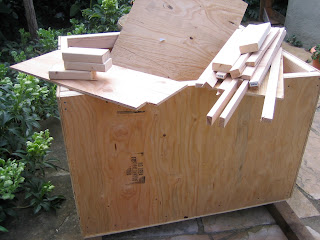This is the stove perched on the ledge I built, to take weight off of
hooks. It feels very sturdy and I will not have any concerns about the stove falling
into the tub.
This is a cage to enclose the stove, it will prevent me from burning my knee
if I forget to keep my distance. (not complete yet)
Here is another view, i originally was going to put the stove in the middle of the 4 foot side but it divided the space up very awkwardly. Having it in the corner will allow for two to comfortably sit but i think that three possibly four people could fit.
Not to shabby looking considering it is $45 worth of lumber and $30 worth of scrap steel.
I have the task of moving the tub to the garage, so it can dry out fully (after a week of almost non stop rain/wetness). I am most likely going to use an oil based "topside gloss black" marine paint from Home Depot. It only needs two coats and it doesn't need to be primed.


















